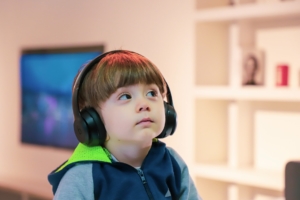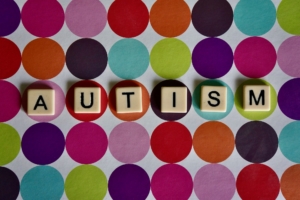When people hear the word neurodivergent initially they think of autism spectrum disorder, a neurological condition characterized by differences in social communication, as well as, sensory-motor behaviors that may be restricted or repetitive.
 While ASD is one of the primary diagnoses of neurodivergent persons, it is not the only one. ADHD, dyslexia and dyspraxia, and other developmental conditions also fall under the neurological conditions that an individual is born with.
While ASD is one of the primary diagnoses of neurodivergent persons, it is not the only one. ADHD, dyslexia and dyspraxia, and other developmental conditions also fall under the neurological conditions that an individual is born with.
The term “neurodivergent” is used to describe normal and naturally occurring differences in the brain that can present in both challenging and positive ways. An individual who is considered neurodiverse exhibits behaviors, learning, and thought patterns that are outside of what is considered neurotypical (normal)
As we have gained more insight into neurodivergent persons, there has been a shift in how people both neurotypical and neurodivergent alike view these differences not simply as disabilities, but see value in the strengths that arise from being different.
Autism Spectrum Disorder
Autism Spectrum Disorder (ASD) is a neurological condition in which the individual’s brain does not develop the same as someone who is neurotypical. Autistic people often experience issues with social communication/interaction, behaviors or interests that may be repetitive or restrictive, and differences in how they learn, move or focus.
According to the CDC (2022), the following is a list of social communication/interactions skills that may be exhibited by an autistic person:
- Avoids or does not keep eye contact
- Does not respond to name by nine months of age
 Does not show facial expressions like happy, sad, angry, and surprised by 9 months of age
Does not show facial expressions like happy, sad, angry, and surprised by 9 months of age- Does not play simple interactive games like pat-a-cake by twelve months of age
- Uses few or no gestures by twelve months of age (for example, does not wave goodbye)
- Does not share interests with others by fifteen months of age (for example, shows you an object that they like)
- Does not point to show you something interesting by eighteen months of age
- Does not notice when others are hurt or upset by twenty-four months of age
- Does not notice other children and join them in play by thirty-six months of age
- Does not pretend to be something else, like a teacher or superhero, during play by forty-eight months of age
- Does not sing, dance, or act for you by sixty months of age
Restrictive/repetitive behaviors or interests.
- Echolalia (continuously repeated words/phrases)
- Obsessive-Compulsive behaviors (placing objects in a certain order and becoming upset if the order is changed, always playing with an object in a certain manner, having to follow a certain routine without deterring from it)
- Being upset when minor changes occur
- Hyper-focus on certain things
- Stimming (repetitive body movements or noises, i.e., flapping hands, rocking back and forth, clicking noises with the mouth, etc.)
- Reacting in unexpected ways to certain sensory stimuli
Symptoms that can be challenging.
While no two people are alike in their symptoms, here is a list of the common symptoms associated with neurological conditions such as ASD, ADHD, OCD, etc.:
- Challenges with social communication
- Speech/language difficulties
- Challenges with learning related to focus, reading, following verbal instruction, calculation, and executive functioning (skills such as working memory, self-control, and flexible thinking).
- Sensory processing issues such as sensitivity/unusual insensitivity to light, heat, cold, sound, pressure, crowd, or other stimuli
- Inflexibility is characterized by an inability to adapt/change specific interests primarily based on age/situation
Symptoms that can be beneficial.
- Hyper-focusing (remaining focused for an extended time) on certain topics or activities of specific interest
- Thinking outside the box, which allows for innovative solutions
- Strong attention to detail and observation skills
- Advanced skills in pattern recognition such as in codes and behaviors
- Strong artistic skills, especially in art, technology, and science
Neurodivergent affirming therapy.
 When working with neurodivergent individuals our best practice is to use affirming language with the client as we understand that individuals may experience and interact with their surroundings in a variety of different ways.
When working with neurodivergent individuals our best practice is to use affirming language with the client as we understand that individuals may experience and interact with their surroundings in a variety of different ways.
As neurodivergent therapists, we strive to understand the client through their lens and use identity-first language such as “an autistic person.” As therapists, we meet the client where they are and provide them with an environment where they are free to express themselves using whatever method is most effective for them.
We understand that not all neurodivergent persons process their emotions the same nor do they communicate in the same way. Our goal is not to change neurodivergent individuals, but rather to help them regulate their emotions and develop skills to aid them in effective communication so that they can live their best life.
What does neurodivergent affirming therapy look like?
A tailored care plan that meets your needs or those of your child focused on the uniqueness of each individual that is supportive of their strengths and abilities. The strengths-based approach highlights the strengths and abilities of the individual rather than their deficits which allows the therapist and client to develop a therapeutic foundation based on their own identified areas of interest
 We believe that all people can think, learn and understand the world around them. Instead of assuming that an individual is lacking the ability to understand certain things, we feel all people are competent and that some may require specific support to help them be more successful.
We believe that all people can think, learn and understand the world around them. Instead of assuming that an individual is lacking the ability to understand certain things, we feel all people are competent and that some may require specific support to help them be more successful.
We work with clients on regulating their emotions rather than adhering to certain expectations by providing them with the emotional and environmental support they need throughout therapy.
We teach advocacy. For many neurodivergent individuals trying to fit into societal norms can increase low self-esteem and anxiety. As therapists, we seek to teach clients self-advocacy skills and support their needs rather than teaching them how to “fit in” according to neurotypical norms.
Neurodiversity describes the idea that people experience and interact with the world around them in many different ways; there is no one “right” way of thinking, learning, and behaving, and differences are not viewed as deficits. – Nicole Baumer, MD, Med Julia Frueh, MD
References:
Baumer, N. Frueh, J. (2021). “What is Neurodiversity?” Harvard Medical School. Retrieved from https://www.health.harvard.edu/blog/what-is-neurodiversity-202111232645
Centers for Disease Control and Prevention (2022). “Autism Spectrum Disorder. Signs and Symptoms of Autism Spectrum Disorder.” Retrieved from https://www.cdc.gov/ncbddd/autism/signs.html#:~:text=Autism%20spectrum%20disorder%20(ASD)%20is,%2C%20moving%2C%20or%20paying%20attention.
Donaldson, A. L, Krejcha, K. McMillin, A. (2017) “A strengths-based approach to autism: Neurodiversity and partnering with the autism community.” Perspectives of the ASHA Special Interest Groups, 1. Retrieved from http://www.readcube.com/articles/10.1044/persp2_SIG1.56
Rudy, L. (2022). “The Neurodivergent Brain: Everything You Need to Know.” Retrieved from https://www.verywellhealth.com/neurodivergent-5216749#toc-signs-of-neurodivergence
Yacoub, A. (2022). “What it means to be Neurodiversity Affirming.” Retrieved from https://therapyworks.com/blog/child-development/what-it-means-to-be-neurodiversity-affirming/
“Listening to Tunes”, Courtesy of Alireza Attari, Unsplash.com, CC0 License; “Happy Couple”, Courtesy of Getty Images, Unsplash.com, Unsplash+ License; “Autism”, Courtesy of Peter Burdon, Unsplash.com, CC0 License; “Legos”, Courtesy of Nathan Dumlao, Unsplash.com, CC0 License










